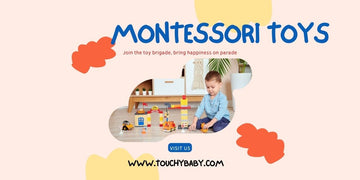How can parents encourage healthy eating? A Guide For Parents
by Touchybaby Admin on Aug 26, 2023

In the fast-paced world we live in, where convenience often takes precedence, instilling healthy eating habits in our children has become more important than ever. As parents, we hold the key to shaping their relationship with food, laying the foundation for their overall well-being.
The choices we make and the examples we set are powerful influencers that can impact their dietary preferences and health throughout their lives. In this guide, we will delve into the art of encouraging healthy eating in children—a task that requires patience, creativity, and a dash of understanding.
Nurturing Healthy Eating Habits in Children: 7 Ways
1: Setting a Positive Example
As parents, we are our children's first and most influential role models. When it comes to healthy eating, our own choices and behaviors can leave a lasting impact on their attitudes toward food.
Here are some effective ways to set a positive example and encourage healthy eating habits in our little ones:
- Diverse Food Choices:
Show your children the importance of a balanced diet by including a wide variety of foods on your own plate. Demonstrate that meals can be both delicious and nutritious by incorporating colorful fruits, vegetables, lean proteins, whole grains, and dairy products.
- Family Meals:
Make family mealtimes a priority. Sit down together for breakfast, lunch, or dinner whenever possible. This not only fosters a sense of togetherness but also allows your children to witness you enjoying a range of foods in a relaxed setting.
- Mindful Eating:
Practice mindful eating by savoring each bite and paying attention to how different foods make you feel. Avoid distractions like screens during meals and encourage your children to do the same. This helps them connect with their hunger and fullness cues.
2: Creating a Supportive Food Environment
The environment in which we surround ourselves greatly influences our choices, and this holds true when it comes to eating habits. As parents, crafting a supportive food environment at home can significantly impact our children's dietary preferences and overall health.
Here's how to cultivate an environment that encourages healthy eating:
- Smart Grocery Shopping:
Begin at the grocery store. When you fill your cart with nutrient-rich options, you're setting the stage for what's available at home. Opt for fresh fruits, vegetables, lean proteins, whole grains, and minimal processed foods.
- Kitchen Makeover:
Arrange your kitchen to promote healthier choices. Place fresh produce at eye level, and make unhealthy snacks less accessible. Having a fruit bowl on the counter and pre-cut veggies in the fridge makes them convenient choices.
- Limit Sugary Drinks:
Keep sugary beverages like soda and excessive fruit juices out of the house. Encourage water as the primary beverage, possibly adding a splash of flavor with infused water or a small amount of 100% fruit juice.
- Snack Strategy:
Prepare a variety of nutritious snack options and have them readily available. This reduces the temptation to reach for less healthy options when hunger strikes between meals.
3: Involving Children in Meal Preparation
Bringing children into the kitchen is not just about cooking; it's a valuable opportunity to teach them about food, nutrition, and the joy of creating something from scratch. When children actively participate in meal preparation, they develop a sense of ownership over their food choices and become more willing to try new and nutritious foods.
Here's how to get them involved:
- Age-Appropriate Tasks:
Tailor tasks to your child's age and abilities. Younger children can wash fruits and vegetables, stir ingredients, or set the table. Older children can handle more complex tasks like chopping (under supervision), measuring ingredients, and even following simple recipes.
- Meal Planning:
Let your children have a say in meal planning. Ask them what healthy meals or dishes they'd like to try. This involvement empowers them and increases their interest in the meals they help create.
- Grocery Shopping Together:
Take your children along when you go grocery shopping. Show them how to choose ripe fruits, fresh vegetables, and other ingredients. Explain why you're selecting certain items.
- Exploring New Ingredients:
Introduce your children to new ingredients and flavors. Let them touch, smell, and taste different foods. This can spark their curiosity and willingness to try unfamiliar dishes.
4: Educating About Nutritional Benefits
Teaching children about the nutritional benefits of different foods is a powerful way to empower them to make informed choices about what they eat. When they understand how various foods nourish their bodies, they are more likely to develop a preference for nutritious options.
Here's how to effectively educate children about the nutritional benefits of food:
- Food Groups and Their Functions:
Introduce children to the basic food groups – fruits, vegetables, grains, proteins, and dairy. Explain the roles each group plays in providing essential nutrients like vitamins, minerals, protein, carbohydrates, and fats.
- Exploring Nutrients:
Discuss specific nutrients found in different foods. For example, explain that oranges are rich in vitamin C, which helps boost the immune system, or that dairy products provide calcium for strong bones and teeth.
- Visual Aids:
Utilize visual aids like colorful charts or diagrams to make learning about nutrients more engaging. Create a "nutrient rainbow" to show the various vitamins and minerals present in different fruits and vegetables.
- Real-Life Examples:
Use everyday situations to illustrate the importance of nutrients. For instance, explain how protein helps repair muscles after physical activity or how carbohydrates provide energy for playing and learning.
- Interactive Activities:
Make learning about nutrition interactive and fun. Create a game where children match foods with their corresponding nutrients, or have them design their own "balanced plate" using play food.
5: Making Healthy Eating Enjoyable
Turning healthy eating into an enjoyable experience is a key strategy for instilling positive habits in children. When they associate nutritious foods with pleasure and excitement, they're more likely to embrace them willingly.
Here are creative ways to make healthy eating a delightful adventure:
- Culinary Adventures:
Transform mealtime into a journey of flavors by exploring cuisines from around the world. Experiment with diverse spices, herbs, and cooking techniques that introduce new tastes and aromas.
- Colorful Creations:
Encourage children to build colorful and visually appealing plates. Incorporate a variety of vibrant fruits and vegetables to make meals not only nutritious but also visually enticing.
- Food Art:
Turn food into art by arranging ingredients into fun shapes or characters on the plate. A smiley face made of fruits or a vegetable "rainbow" can make healthy eating exciting.
- Playful Presentations:
Present meals in unconventional ways. Serve yogurt parfaits in clear glasses, create fruit kabobs, or make a "build-your-own" salad bar, allowing children to assemble their favorite combinations.
- Themed Meals:
Organize themed meals around children's favorite books, movies, or characters. For instance, create a "Frozen" theme with icy blue smoothies and snowflake-shaped whole wheat sandwiches.
- Garden-to-Table Experience:
If possible, grow a small vegetable or herb garden. Let your children participate in planting, tending, and harvesting. Eating what they've nurtured can be incredibly rewarding.
6: Avoiding Food-related Pressure
In the quest to encourage healthy eating habits in children, it's important to strike a balance between guidance and avoiding undue pressure. Pressure around food can lead to negative associations and even contribute to disordered eating behaviors.
Here's how to foster a positive and stress-free approach to eating:
- Respect Appetites:
Recognize that children have varying appetites, and their hunger levels can fluctuate. Allow them to eat when they're hungry and stop when they're full, avoiding any pressure to finish every bite.
- No Forced Consumption:
Avoid forcing children to eat certain foods or finish their plate. This can create a negative association with those foods and disrupt their natural ability to regulate hunger.
- Variety, Not Force:
Introduce a variety of foods without insisting they eat them. Let your children explore different tastes at their own pace. Repeated exposure often leads to eventual acceptance.
- Balanced Approach:
Emphasize balance over perfection. Allow room for occasional treats and less nutritious foods, showing that all foods can be enjoyed in moderation.
- Neutral Language:
Use neutral language when discussing food. Avoid labeling foods as "good" or "bad." Instead, talk about how some foods offer more nutrients and energy, while others are meant for occasional enjoyment.
- No Food as Reward or Punishment:
Avoid using food as a reward for good behavior or as punishment for misbehavior. This reinforces emotional connections to food and can lead to unhealthy habits.
7: Encouraging Mindful Eating
In our fast-paced world, teaching children the practice of mindful eating can help them develop a healthier relationship with food, enhancing their appreciation for nourishment and reducing overeating. Mindful eating involves being fully present during meals, savoring each bite, and listening to one's body cues.
Here's how to cultivate mindful eating habits in children:
- Slow Down:
Encourage your children to eat slowly and savor each bite. Discuss the textures, flavors, and aromas of the food. This not only enhances their enjoyment but also allows their bodies to recognize when they're full.
- Eliminate Distractions:
Create a distraction-free zone during meal times. Turn off screens and focus on the meal, allowing your children to connect with their senses and the experience of eating.
- Engage the Senses:
Encourage your children to use all their senses while eating. Discuss the colors, smells, textures, and sounds of the food. This sensory exploration enhances their connection to the meal.
- Portion Awareness:
Teach your children to serve themselves reasonable portions and to pay attention to their bodies' hunger and fullness cues. This helps prevent overeating.
- Chew Thoroughly:
Discuss the importance of chewing food thoroughly. This aids digestion and allows children to fully appreciate the taste and texture of what they're eating.
Conclusion:
In the journey to encourage healthy eating habits in children, we find that the power lies not in restrictions or pressure, but in fostering a positive and supportive environment.
From setting a positive example and involving children in meal preparation to educating them about nutritional benefits and practicing mindful eating, every step we take contributes to shaping their lifelong relationship with food.
As parents, caregivers, and role models, we have the unique opportunity to instill values that go beyond nutrition labels. By approaching food with curiosity, creativity, and a sense of enjoyment, we set the stage for children to embrace a diverse range of nutritious choices.




